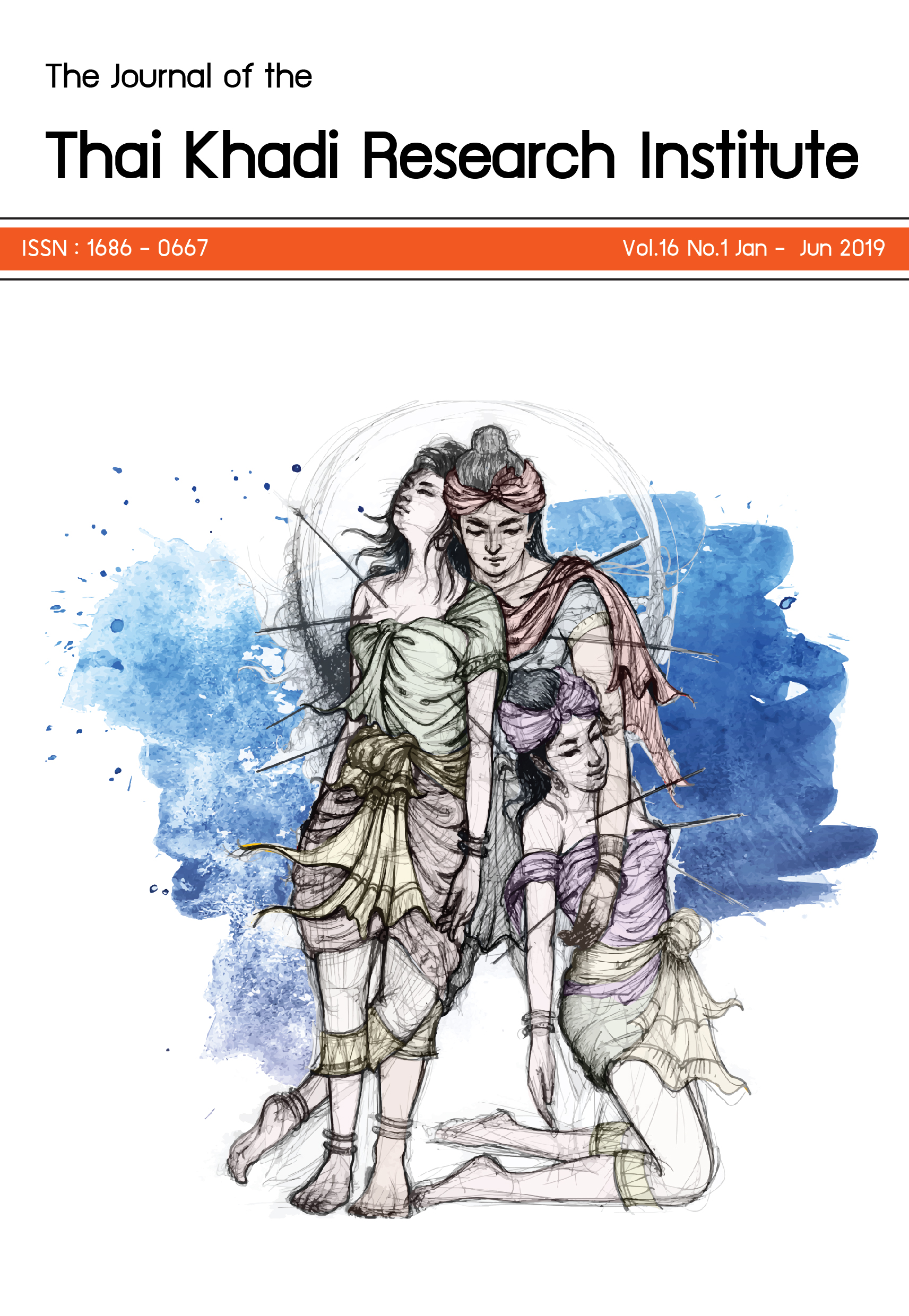ฟ้อนม่านมุยเซียงตา: อิทธิพลนาฏกรรมพม่า ในสังคมไทย ศึกษาวิเคราะห์ความหมายของ ชื่อชุดการแสดง บทขับร้อง และโครงสร้าง ของทำนองเพลง
Main Article Content
บทคัดย่อ
บทความวิจัยชิ้นนี้มีวัตถุประสงค์เพื่อศึกษาถึงประวัติ และความหมายของชื่อชุดการแสดง บทขับร้อง และทำนองเพลงที่ปรากฏในการแสดงชุดฟ้อนม่านมุยเซียงตา โดยใช้ระเบียบวิธีวิจัยเชิงประวัติศาสตร์ แนวคิดทางภาษาศาสตร์ และการวิเคราะห์โครงสร้างทางดนตรีมาเป็นกรอบในการศึกษา จากการศึกษาพบว่า “ฟ้อนม่านมุยเซียงตา” เป็นการแสดงที่เกิดขึ้นจากการเลื่อนไหลทางวัฒนธรรมข้ามแดนระหว่างไทยและพม่าที่มีมาอย่างต่อเนื่องและยาวนาน โดยชื่อการแสดงชุดนี้มีที่มาจากชื่อเพลง “เวซะยันตา” ซึ่งเป็นเพลงพม่าสำเนียงโยธยาที่ไทยนำมาบรรเลงเป็นเพลงแรกของชุดการแสดง โดยใช้บทขับร้องที่มีสำเนียง และข้อความบางคำคล้ายคลึงกับภาษาพม่า ที่เมื่อนำมาวิเคราะห์ก็พบว่ามีความหมายไปในเชิงรำพันถึงคนรักภายใต้สภาพแวดล้อมของป่าเขาอันทุรกันดาร ซึ่งแตกต่างไปจากบทขับร้องในเพลง “เวซะยันตา” ของพม่าที่บรรยายถึงสภาพความงามของเมืองมัณฑเลย์ ส่วนทำนองเพลงฟ้อนม่านมุยเซียงตา โดยเฉพาะในเพลงแรกมีโครงสร้างของทำนองตรงกับเพลง”เวซะยันตา” ของพม่ากว่าร้อยละ 75
Downloads
Article Details
ผู้เขียนจะต้องลงนามในแบบฟอร์มรับรองบทความ เพื่อให้คำยืนยันความรับผิดชอบว่า บทความของผู้เขียนนั้นไม่เคยตีพิมพ์ที่ใดมาก่อน พร้อมรับทราบว่า กระบวนการส่งบทความเข้าพิจารณาและตีพิมพ์ในวารสารไทยคดีศึกษานั้น จะไม่มีการเรียกเก็บค่าใช้จ่ายในการดำเนินการ ยกเว้น ในกรณีที่ผู้เขียนขอยกเลิกการตีพิมพ์บทความในวารสารไทยคดีศึกษาไม่ว่าด้วยสาเหตุใด และหลังจากบทความนั้นเข้าสู่กระบวนการพิจารณาของผู้ทรงคุณวุฒิไปแล้ว ผู้เขียนจะต้องรับผิดชอบต่อค่าใช้จ่ายที่เกิดขึ้นในกระบวนการประเมินเป็นจำนวนเงิน 3,000 บาท (สามพันบาทถ้วน)
เอกสารอ้างอิง
Amatayakul, P. (n.d.). Tūan sī wō̜ra wan, mō̜mlūang (sō̜ngphansīrō̜isipčhet - sō̜ngphanhārō̜isipčhet) [Worawan, T, M.R. (1874 - 1974)]. Retrieved October 22, 2016, from http://mulinet3.li.mahi dol.ac.th/elib.
Charenchai, B. (1998). Chāng mư̄ang phet: withī chīwit rūamsamai khō̜ng chāng pūnpan phet burī [Craftsmen of Phetburi: contemporary life of Phetburian sculptors] (Master’s thesis, Anthropology, Thammasat University).
Chuphan, W. (1986). Kān phǣndin kap nāt sinlapa dontrī Chīang Mai [Politics and Performing Arts of Chiang Mai]. In Sasiwanit, S. & Sisomphet, L. (ed.), Thīralư̄k dontrī Thai ʻudomsưksā khrang thī Sipčhet [Proceedings of 17th Higher Education Thai Music Concert] (28 - 52). Chiang Mai: Changphuak Press.
Chutinthranon, S. (1995). Burēngnō̜ng kayō̜dinnō̜rathā kasat Phamā nai lōk that Thai [Burengnong Kayodinnortha The Burmese King in Thailand Mindset]. Bangkok: Amarin Phrinting.
Damrong Rajanubhab, Somdekromphraya. (1971). Thīeo mư̄ang Phamā [Travel to Burma]. Bangkok: Phrae Phittaya.
Fine Arts Department. (1992). Laksūt nāttasin chan klāng Phutthasakkarāt sō̜ngphanhārō̜iyīsipsī (Chabap prapprung Phō̜.Sō̜. sō̜ngphanhārō̜isāmsipsī) [Dramatic Arts Progrm II (Revision 1991)]. (n.p.).
Jiajanpong, P. (2002). Wongthet, S. (ed.), Mahārātchawongphongsāwadān Phamā nāi thō̜ng tō̜ plǣ [Maharajawong Myanmar chronicle, Mr.Thongto translation] (14, 21 - 23). Bangkok: Matichon.
Kanchanacharee, N. (1990). Dārā Ratsamī [Dara Ratsami]. Bangkok: Three Dee Kanphim Co.,Ltd.
Khamkoet, P. & Khan Atam, N. (1995). Phrarātchayāčhaodārāratmī kap nāttasin læ dontrī Thai [Royal princess Dararatsami with the dance and Thai music]. In Chiang Mai University (ed.), Thīralư̄k dontrī Thai ʻudomsưksā khrang thī yīsiphok [Proceedings of 26th Higher Education Thai music Concert] (82 - 90). Chiang Mai: Chiang Mai University.
Ko Ko Hnai, Rāmañña. (1985). Mrn̔mā Soṅ̒ “Si Koṅ̒ “Cayā Nhṅ̒ ’Tat̒ Koṅ̒ “Cayā [Interesting Burmese Harp]. Yangon: Cāpe Bimān̒.
Ministry of Culture. (2001). Mrn̒mā ̕Anusukhuma ̕Abhidhān̒ [Dictionary of Myanmar Performing and Plastic Arts]. Yangon: Mettā Poṅ Nhip̒ tuik̒.
Ministry of Culture. (n.d.). Myanmar Pattala, Music Notation Volume 1, No.1 [The Bamboo Xylophone of Myanmar]. (n.p.).
Mung Muan Tin, U. (1989). Kuṅ̒ ˝bhoṅ̒ Chk̒ Mahā Yājavaṅ̒ to̒ Krī˝ [Chronicles of the Konbaung dynasty]. Yangon: Laiy̒ tī Maṇḍuiṅ̒ Poṅ Nhip̒ tuik̒.
Mung Muan Tin, U. (1999). Chalœ̄i Thai nai mantha lē [Thai captives in Mandalay] In Chutintharanon (ed.), Phamā ‘ān Thai: wādūai prawattisāt læ sinlapa Thai nai thatsana Phamā. [Myanmar read Thai: on the history and art in the perspective of Myanmar] (129 - 145). Bangkok: Mati chon.
Myankyi. (1999). Botphlēng yōtha yā sām phlēng ʻan sadǣng thưng laksana Thai nai prathēt Phamā yuk čhārīt [The three of Yodaya song that represents Thai style in Myanmar Traditional Time]. In Chutinthranon, S. (ed.), Phamā ‘ān Thai: wādūai prawattisāt læ sinlapa Thai nai thatsana Phamā [Myanmar read Thai: on the history and art in the perspective of Myanmar] (173 - 190). Bangkok: Matichon.
Myanmar Socialism Party. (1983). Mrn̒mā Jāt̒ sabhiṅ̒ Taket̒ Proṅ̒ ˝ lai Re˝ [The changes of the Myanmar entertainment through times]. Yangon: Cāpe Bimān̒.
Naksuk, Y. (2005). Kham Phamā nai phāsā læ wannakam lān nā [The Myanmar word in Lanna language and literature]. Thai Magazine, 8(1), 47 - 91.
Niyomtham, W. (1994). Photčhanānukrom Phamā - Thai læ Thai - Phamā [Myanmar - Thai and Thai - Myanmar Dictionary]. Bangkok: Compact Print Co.,Ltd.
Orts, P. (1996). Lānnā Thai nai phǣndin Phraphutthačhaolūang [Lanna Thai, in the reign of King Chulalongkorn]. Bangkok: Karan Publisher.
Phothiyarom, D., Hatsadi, T. & Netniyom, S. (2007). Itthiphon watthanatham Phamā thī prākot nai bot khaprō̜ng læ thamnō̜ng phlēng thī chai nai kān sadǣng chut fō̜n mān muisīang tā: sưksā læ wikhro̜ chapho̜ kō̜ranī prawat khwāmmāi læ khrōngsāng khō̜ng botphlēng [Influences of Burmese Cultures Appearing in the Contents and the Tune of the Song of Man Mui Chiangta Dance: A Case Study of the History, the Meanings and the Structures of the song]. Chiang Mai: Chiang Mai College of Dramatic Arts.
Prachadetsuwat, R. (1999). Phrarātchayāčhaodārāratsamī kap kān nāttasin [Royal princess Dararatsami with the dance]. In Kaeokiriya, R, M.R. (et al). (ed.), Dārā Ratsamī sāiyai rak sō̜ng phǣndin [Dararatsami, the love bound of two cities] (307 - 320). Bangkok: Chulalongkorn University Press.
Punnothok, T. (2009). Phāsā thin [Dialect]. Bangkok: Ramkhamhaeng University.
Rungruangsi, U. (1999). Fō̜n kambœ̄ (fō̜n phīsư̄a rư̄ fō̜n mān mui chīang tā). [Kamber dance (Butterfly dance or Manmui Chiangta dance)]. In, Sārānukrom watthanatham Thai phāk nư̄a lem kao [Northern Thailand Cultural encyclopedia Volume 9]. Bangkok: Thai Commercial Bank, Thailand Cultural Foundation encyclopedia.
Rungruangsi, U. (1999). Hong hin khāo sō̜. [The Poem of Hong hin story]. In, Sārānukrom watthanatham Thai phāk nư̄a lem sipsī [Northern Thailand Cultural encyclopedia Volume 14] (7268). Bangkok: Thai Commercial Bank, Thailand Cultural Foundation encyclopedia.
Rungruangsi, U. (1999). Mān (Phamā) [Mam (Burmar)]. In, Sārānukrom watthanatham Thai phāk nư̄a lem sip [Northern Thailand Cultural encyclopedia Volume 10] (5153 - 5156). Bangkok: Thai Commercial Bank, Thailand Cultural Foundation encyclopedia.
Sawatdiphong, C. (2003). Phrarātchayāčhaodārāratmī kap sinlapa kān fō̜n lānnā. [Phraratchaya Chao Dararatsami and the art of Lanna Dance]. Thai Magazine, 6(1), 150 - 159.
Saya, U Pyoun Chou. (1968). Mahāgīta Poṅ̒ ˝khup̒ Kyam̒ ˝ [Mahagita Anthology]. Yangon: Paññā ̕Aliṅ̒˝ Cāpe.
Singer, Noel F. (1999). Rāmmakīan nai rāt samnak pai čhāk ʻAyutthayā [The Ramayana in the court coming from Ayutthaya]. In Chutinthranon, S. (ed.), Phamā ‘ān Thai: wādūai prawattisāt læ sinlapa Thai nai thatsana Phamā [Myanmar read Thai: on the history and art in the perspective of Myanmar] (147 - 172). Bangkok: Matichon.
Thbin Wun, U Nu. (1967). Mrn̒mā Sabhiṅ̒ Loka [Entertainment World of Myanmar]. Yangon: Cāpe Bimān̒.
Thepwong, S. (2004). Sārānukrom rabam ram fō̜n [Encyclopedia of Dance]. Bangkok: Odian store.
Wichasin, R. (2002). Kham mān khammư̄ang [Myanmar, Lanna words]. Thai Magazine, 5(2), 15 - 24.
Yuangsi, T. (1997). Kāndontrī Kānkhap Kānfō̜n Lānnā [Music, Chorus and Dance of Lanna]. Chiang Mai: Suriwong Book Center.
Interviewee:
Kin Hia, U. A Myanmar music teacher. 24 September 2007.


